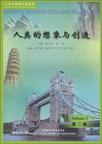人类文明与文化读本·人类的想象与创造(第2卷)
出版时间:2008-9 出版社:外语教学与研究出版社 作者:顾曰国 编 页数:347
内容概要
一个成熟的英语学习者能够用英语进行广泛的阅读并从中收获知识和快乐。让我们为知识和快乐而阅读,而不仅仅是为学好英语而阅读。 “人类文明与文化读本“(READ INTO HUMAN CIVILIZATION AND CULTURE)是针对高校英语专业学生和同等程度的英语学习者开发的一套阅读文库,可以用作泛读课教材.也可以用作课外阅读材料。与一般泛读教材不同的是.本套读本着眼于让读者通过英语的视角来了解上下数千年人类所创造的文明、文化以及所遭遇的挑战和危机。
书籍目录
Table of ContentsGeneral Introduction to Read into Human Civilization and CultureIntroduction to Humans Imagination and RecreationPart 1 A Survey of Arts, Theater and LiteratureUnit 1 A Survey of ArtsText A General Concepts for the Work of ArtsText B Specialized Concepts for the Work of ArtsUnit 2 Introduction to the Study of Theater ArtsText A Dramatic Arts and Theater PresentationText B Theaters in the West: Change and DevelopmentText C What Shakespeare the Dramatist Has to Say About ActingUnit 3 Introduction to the Study of LiteratureText A What Do We Mean When We Speak of Literature?Text B The Book—— Still Precious Lifeblood of a Master SpiritText C Love Disappointed: Poems from Various Times and Places on a Common Aspect of Human ExperiencePart 2 Religion and ArtsUnit 4 Art in the Service of ReligionText A People Make Meaning from Their ExperiencesText B Religious Festivals and CeremoniesText C Artistic Tradition and the Social OrderUnit 5 Conflict and Contradiction in the Relation Between Religion and ArtsText A Arts as a Dimension of ReligionText B1 Dispute over IconsText B2 The Impact of PuritanismUnit 6 Communicating Ideology Through Drama, Religious Myth and LegendText A The English Mystery PlaysText B The Medieval Miracle PlaysPart 3 Music and Western CultureUnit 7 Music and MusiciansText A An Introduction to the Music Culture of the WestText B The Great Musicians of the Classical and Romantic Tradition in Western MusicUnit 8 Opera and BalletText A A Brief History of OperaText B The Development of Ballet: Classical to ModemText C Opera in Five ActsUnit 9 Popular Music and Popular CultureText A Popular MusicText B The Development of Music and Popular CulturePart 4 Sculpture and ArchitectureUnit 10 A General Survey of SculptureText A Understanding SculptureText B Sculpture: A Glorious PastText C Sculpture: Far and WideUnit 11 A General Survey of ArchitectureText A Architecture: The Ancient WorldText B Architecture: The Medieval WorldText C Architecture: More Recent TimesUnit 12 East and West: Two Case StudiesText A Aspects of the Architecture and Sculpture of IndiaText B Hidden Gems Among the Gothic Spires of YalePart 5 Sports and CultureUnit 13 Among the Sports We HaveText A BasketballText B BoxingText C SoccerUnit 14 Sports as an IndustryText A The Olympic GamesText B Sports IndustryText C The World CupUnit 15 The Other Side of SportsText A Forget the Footie, Check out the TechnologyText B Seconds out, Round Two of My LifeText C Mother of All ClimbdownsPart 6 Trends in Modern ArtsUnit 16 Modernism and Modern ArtsText A Modem ArtText B Modem DanceUnit 17 The Role of FeminismText A Women in ArtText B Self-portrait by Gwen JohnText C The Fortunes of Women Painters and Their Work.Unit 18 Advertising and ArtText A AdvertisingText B Early Advertising Art from A. and E Pears LtdKey to QuestionsGlossary
章节摘录
1. In architecture Works of architecture are so much a part of our environment that we accept them as fixed and scarcely notice them until our attention is summoned. People have long known how to enclose space for the many purposes of life. The spatial aspect of the arts is most obvious in architecture. The architect makes groupings of enclosed spaces and enclosing masses, always keeping in mind the function of the structure, its construction and materials, and of course, its design —— the correlative of the other two. We experience architecture both visually and by moving through and around it, so that we perceive architectural space and mass together. The articulation of space and mass ~ in building is expressed graphically~ in several ways; the principal ones include plans, sections, and elevations. Aplan is essentially a map of a floor, showing the placement of the masses of a structure and, therefore, the spaces they bound and enclose. A section, like a vertical plan, shows placement of the masses as if the building were cut through along a plane, often along a plane that is a major axis of the building. An elevation is a head-on view of an external or internal wall, showing its features and often other elements that would be visible beyond or before the wall. Our response to a building can range from simple contentment to astonishment and awe. Such reactions are products of our experience of a buildings function, construction, and design; we react differently to a church, a gymnasium, and an office building. The very movements we must make to experience one building will differ widely and profoundly from the movements required to experience another. These movements will be controlled by the continuity (or discontinuity) of the plan or by the placement of its axes. For example, in a central plan —— one that radiates from a central point, as in the Pantheon in Rome —— we perceive the whole spatial entity at once. In the long axial plan of a Christian basilica ~ or a Gothic cathedral however, our attention tends to focus on a given point —— the altar at the eastern end of the nave. Mass and space can be interrelated to produce effects of great complexity, as, for example, in the Byzantine Church of the Katholikon or in Le Corbusiers church at Ronchamp.
图书封面
评论、评分、阅读与下载
人类文明与文化读本·人类的想象与创造(第2卷) PDF格式下载
